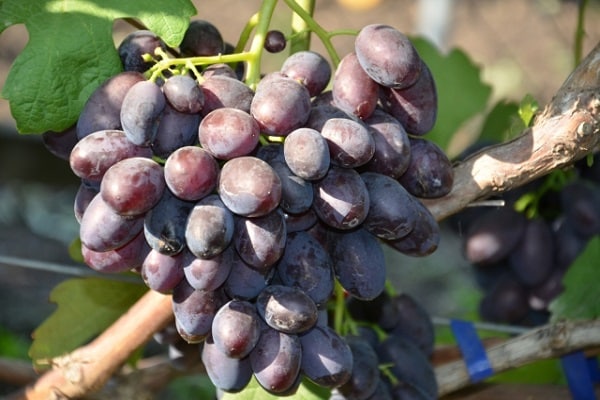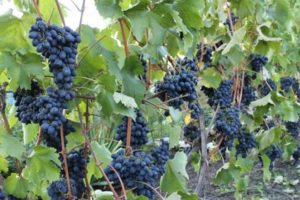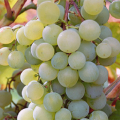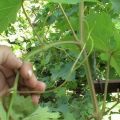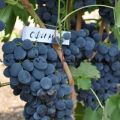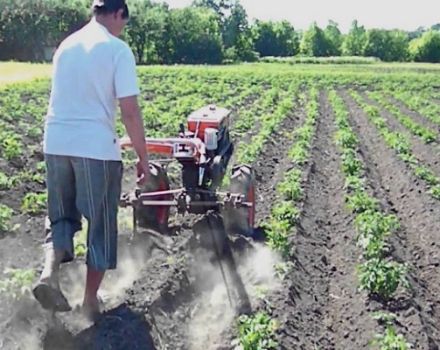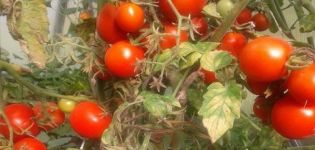Description and characteristics of the Catalonia grape variety, fruiting and growing rules
The progenitors of the Catalonia grapes were the Talisman and Burgundy Magnolia (Mantle) varieties. The aesthetic appeal of the plant, its bunches, came from the Burgundy Magnolia, and the delicacy of the berry's taste was received from the Talisman. The breeder Alexander Vasilyevich Burdak presented the gardeners with this self-fertile table grape variety with bisexual flowers.
Description of Catalonia grapes
Fruiting of the Catalonia variety begins from the first season after planting. The grapes growing in Ukraine, Belarus, Moldova do not require any special care. This variety is not the most suitable for the cold regions of the North-West, the Moscow region, the Baltic states, it will have to be carefully covered on the eve of winter.
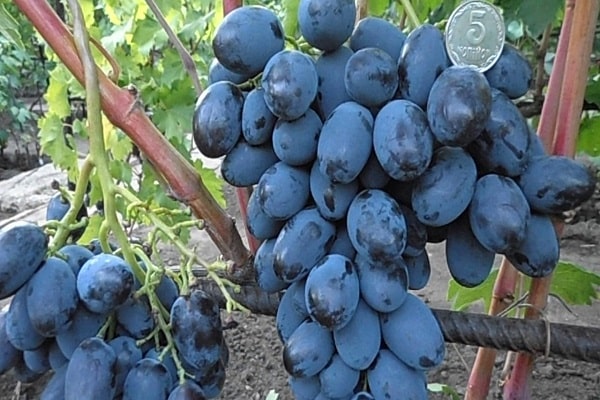
The bush of this variety has a powerful structure, massive clusters weighing from 600 g to 1 kg are easily held on the vine. The bushes are generously covered with massive conical clusters.
Depending on the region of growth, the variety can be attributed to both early and mid-season. In warm regions, the berries begin to ripen by the end of July; in mid-latitudes, you can enjoy their taste not earlier than the last decade of August.
Origin of the variety
The variety is bred by the usual crossing of two grape varieties with large red and blue fruits. What improved the taste of one and the appearance, transportability of the other.
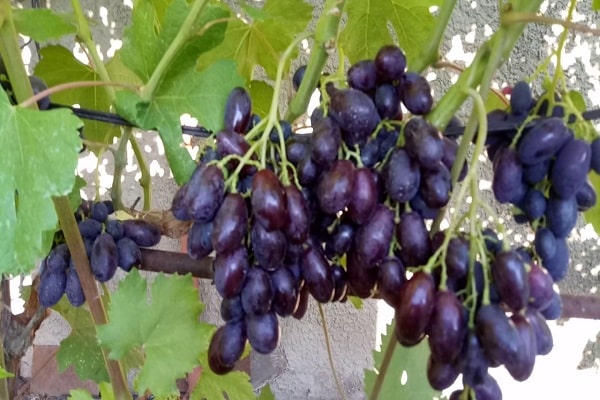
Description of the bush
Bushes vigorous, spreading, hardy to stress. Shoots growing together reinforce each other. Medium-sized dark green leaves. The veins do not differ in color, but clearly stand out on the leaf plate.
The seedling takes root quickly in fertile soils. The plant is highly adaptable to climatic conditions. Immediately after planting, the plant begins to root intensively, simultaneously with this stage, the vine is formed.
The first harvest consists mainly of bunches not exceeding 500-600 g. Proper plant care will increase the yield by increasing the weight of each berry (from 12 to 18 g).
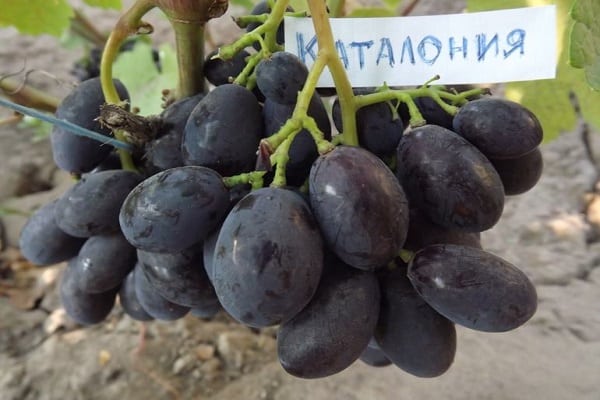
Main characteristics
Catalonia is not highly resistant to frost. The maximum cold snap that the bush will withstand during the winter without consequences is -23 ° C. Resistant to fungal diseases and insect pests. Fruiting profuse, annual.
Sweet and juicy berry
The grapes of the Catalonia variety attract with their aroma and juiciness of wasps and birds. It is extremely difficult to damage the thick skin of wasps, but the crop can be badly damaged by the beaks of the birds. Large berries growing in weighty bunches are more often used for making wine than for eating raw. Tasting assessment of the taste of Catalonia - 8.9 points out of 10 possible.

The tart aroma of the skin is mixed with the sweet taste of the pulp, which gives an astringent aftertaste. This combination of pulp and rind flavors is typical of the grape varieties grown for wine making.
Immunity from diseases and pests
The grape bushes of Catalonia are resistant to fungal pathogens - mildew, oidium, gray rot. Most insect pests do not like this vine variety. The tart aroma of the peel of the berries scares away leaf rollers, phylloxera
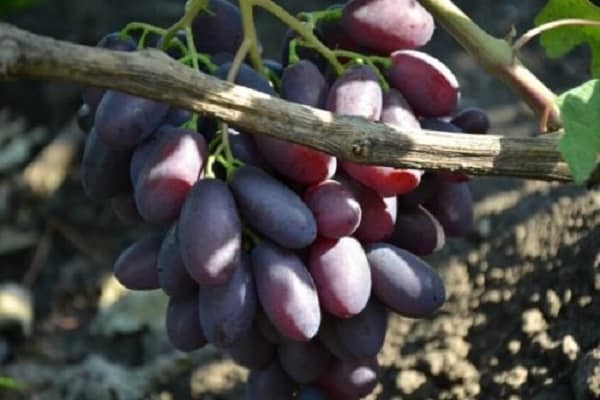
What is special and how the variety differs from others
The peculiarity of the variety lies in its tendency to fasciation - the accretion of stems. This cannot be considered a disadvantage, because the shoots of the vineyard have to withstand a solid load.
Bunches of grapes ripen simultaneously and evenly, withstand a long shelf life without losing their presentation and taste. When ripe bunches are left on the vine, the berries also do not wrinkle and do not lose their taste. The berries of the Catalonia grape variety are not prone to peas.
The plant develops poorly on soil with high acidity, does not tolerate waterlogging, prone to chlorosis, mold. The roots freeze under severe frosts, which affects the health of the bush and the quality of the crop.
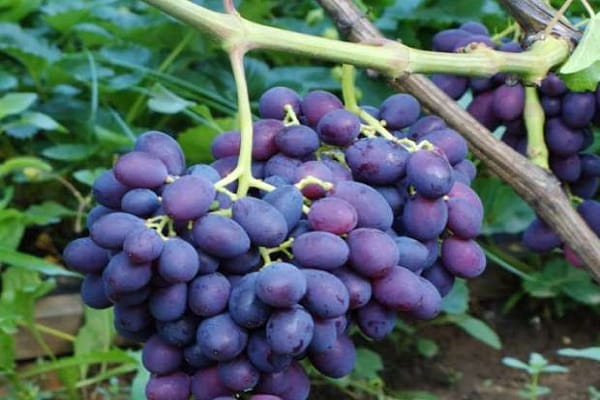
Landing in the ground
Before planting grape seedlings in the ground, their roots must be soaked in water for a day. If the soil is not fertile, then a growth regulator can be added to the water. It promotes better rooting and shoot formation.
Preparing the landing site
The planting site must be leveled, weed roots, stones must be removed from it. When choosing a place, it is necessary to take into account that the seedlings must be exposed to the sun's rays and sheltered from the winds. The lean soil must be saturated with mineral fertilizers, the acidic soil must be normalized with fluff lime, and preferably ash.
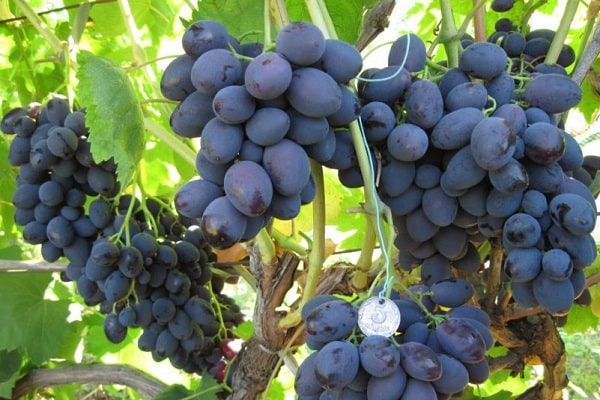
Choosing seedlings
A young seedling has brown shoots with a greenish tint. The gray, dark brown color of the bark indicates that the seedling is old. It is not suitable for planting, its adaptation to a new place will be long and painful.
Peeling, bumpiness on the bark are signs of diseases. Damage to the bark, breaking of branches are the places of greatest risk for infection by fungi and bacteria. Such seedlings are also not suitable. There should be no damage to the rhizome of the plant.
Landing calendar
From mid to late October, it is necessary to plant a seedling in a previously prepared hole. The favorable days for planting change every year. What remains unchanged is that it is recommended to transplant plants on a growing moon, and not on a waning one. If we attribute grapes to berry bushes, then suitable days are 2, 3, 11, 12, 15, 16, 20, 21, if Catalonia, due to its high growth and the peculiarity of accretion of shoots, is attributed to fruit trees, then it should be planted 11, 12, 15 , 16, 20, 21, 25, 26 numbers. You cannot plan planting on the 8th, 9th, 10th, 24th, it will be more difficult for the plant to adapt and enter the stage of painless rooting.
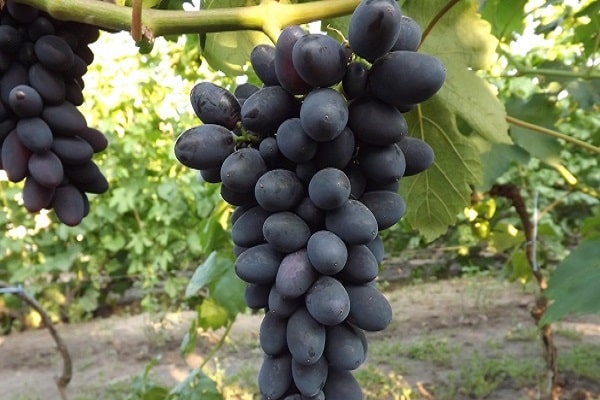
Sequence of steps when disembarking
The landing hole is prepared in advance, approximately 10-14 days before landing. The recommended width and depth is 1 m. It is partially filled with:
- 15-20 cm - drainage layer.
- Soil mixed with humus and mineral fertilizers necessary for autumn feeding (the exact list of mineral additives is specified in accordance with the characteristics of the district's soil).
- The enriched soil is covered with soil selected from the hole.
- Humidification is performed - 10 liters of water.
The day before planting, the root system of the seedling is soaked in water. Immediately before planting, the roots are treated with a weak solution of potassium permanganate. This will protect the roots from insect pests, worms:
- The processed seedling is set in the middle of the hole on an earthen elevation.
- Its roots are gently straightened.
- The hole is 2/3 filled with soil (in chernozem areas with simple soil, in non-chernozem areas with enriched compost, humus, manure).
- Watering is carried out, which will allow the soil to be somewhat compacted.
- The hole is filled with soil to the top.
- After the land is compacted, the plot is mulched.
Garter for a fast growing bush of Catalonia grapes is a must.
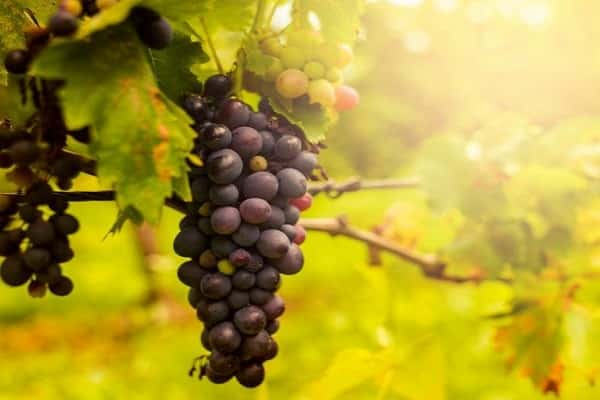
Growing and care
Proper care ensures the health of the shrub and a good harvest for the grower.
Pruning a bush
With autumn and spring pruning, old shoots are removed, they differ from the rest by gray, flaky bark. Pruning of vines, leaves, shoots affected by disease or insects is performed immediately after the detection of the disease. Weak and thin shoots are also cut off, they only pull off juice from strong shoots, which will affect the size of the bunches.
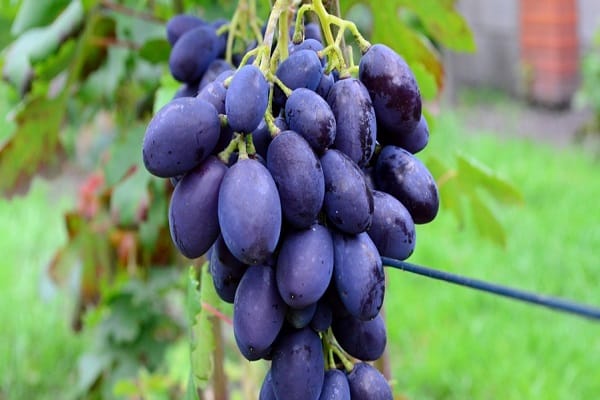
Watering
Systematic watering of Catalonia grapes during the vegetative stage of the plant is recommended in areas with hot arid climates. Catalonia will not withstand strong moisture, it can be affected by a putrefactive fungus. In cold regions, abundant watering is recommended for the plant at the stages:
- blooming buds;
- flowering;
- the formation of bunches - their weight gain;
- before the onset of winter frosts.
Attention! Watering is not done 4 weeks before the planned harvest. The more moisture the grapes receive during this period, the more acids and less sugars there will be in its juice.
Fertilizer
Before the flowering period and during the formation of ovaries, the soil at the roots is enriched with nitrogen-containing fertilizers. Mineral dressings are applied as needed, which depends on the soil in which the vineyard is planted.
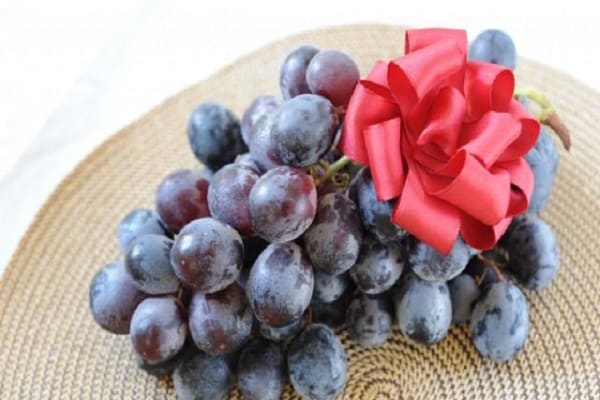
How to protect against diseases and pests
Preventive measures:
- timely protection against frost;
- high-quality feeding;
- spraying with insecticides before the vegetative stage;
- cleaning of fallen leaves and fruits from under the bush;
- regular replacement of mulch after winter and harvest;
- pruning of affected and damaged shoots as they are found.
Preventing disease is easier than curing it by risking the crop.
Ripening berries
Ripening of the Catalonia grape variety occurs at the same time. In Ukraine, Belarus, Moldova, Krasnodar Territory, it falls on horses in July, in central Russia, on horses in August - early September.
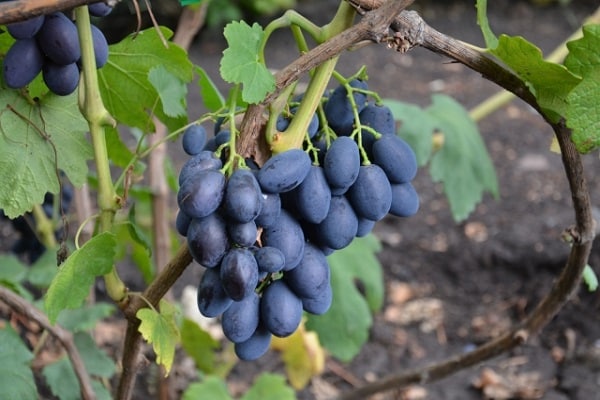
Terms of fruiting
After planting, already for the first season, the bushes of Catalonia delight with a decent harvest. From the beginning of the growing season to harvest in different climatic zones, it takes from 90 to 110 days.
Preparatory work before winter
In climates where winters are not particularly harsh, the thermometer does not fall below -23 ° C, the grapes of the Catalonia variety are not threatened by freezing of the roots and shoots. It is enough to carry out high-quality soil mulching here. Where there is a threat of frequent thaws, it is necessary to drain and drain melt water from the plants.
In cold regions, it is necessary to cover the vineyard with a film, creating greenhouse wintering conditions for it, and with each snowfall, increase the snowdrift next to it. The thicker the snow layer, the less the ground will freeze.
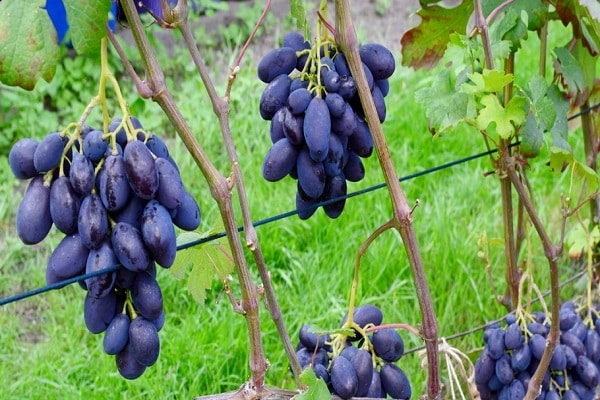
Harvesting and using the crop
The harvest of Catalonia grapes is carried out at the stage of full maturation. For some time, ripe bunches can hang on the bushes without any harm to the grower. After harvesting, the grapes can be sent for storage, sale, processing into wine must.
